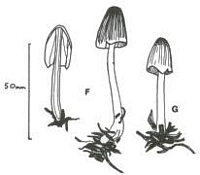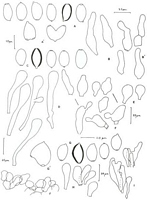|
 Bolbitius titubans Bolbitius titubans
SynonymsAgaricus titubans
BiostatusPresent in region - Exotic
Images (click to enlarge)
Caption: F-G Taylor 190, G. Immature basidiomata with section (F). | 
Caption: A, D-F Segedin 1161, A. Basidiospores (A' biporate); D. Pileipellis units; E. Pleurocystidia; F. Caulocystidia. B-C Segedin 1171, B & B' Cheilocystidia; C. Basidiospores. G-J Taylor 1260, G. Basidiospores (G' biporate); H. Pileipellis; I. Caulocystid |
Article: Watling, R.; Taylor, G.M. (1987). Observations on the Bolbitiaceae: 27. Preliminary account of the Bolbitiaceae of New Zealand. Bibliotheca Mycologica 117: 61 p. + 17 pl.
Description: The microscopic data are as follows;-
Basidiospores 10.5-13(-14) x 6-7.5(-8.5) µm, ellipsoid to heart shaped, lobed, lenticular, smooth, thick-walled, strongly pigmented (very dark brown); germ-pore prominent, broad, frequently paired. Basidia 1-, 2-, 3-, 4-spored, mostly 2-spored, 20-25 x 9-10 µm, Cheilocystidia (30-) 35-60 x 9.5-18 µm, clavate-vesiculose, spheropedunculate, hyaline, some twinned - (rabbit-ear shaped); pleurocystidia absent. Pileipellis of clavate to spheropedunculate hyaline cells, often with long pedicel, 35-50 x 10-15 µm. Clamp-connections absent.
Notes: Several collections examined possess the delicate facies of an agaric which in Europe has been interpreted as B. titubans (Watling, 1982). Without more extensive field data, however, the majority of records cannot be substantiated. A collection from Piha Valley (1 iv 1974, legit J.C. Segedin, Segedin 1171) and one from above Huka Falls (on mown grass-straw, beside Waikato River, 27 x 1982, Taylor 1260) possessed the broader basidiospores associated with B. titubans. Taylor 190 (with grass, roadside bank, Holmes St., Oamaru, 26 iv 1964, legit L R Taylor) is immature but may represent the same taxon. in the Huka Falls collection some development of biporate spores was observed, something which was found to an even greater degree in Segedin 1161 (in grass outside entrance to Kauri Glen, Auckland, 28 iv 1974). Unfortunately the little field data available only indicates that the agaric is coloured much the same as members of the B. vitellinus group.
The large number of bi-porate basidiospores resemble those of many members of the strophariaceous gastromycetoid series; similar spores have been found in collections of Agrocybe from Kashmir and Poona, India (Watling & Abraham, in press). This fungus needs to be refound in New Zealand. In some ways the collection resembles Gastrocybe lateritia Watl. and G. incarnata (Peck) Baroni, although it is a typical agaric. This is yet another example of a bolbitiaceous fungus which reduces the hiatus between the true agarics and the so-called gastromycetes (secotioid). The Segedin collection lacks the colour typical of G. lateritia and G. incarnata but resembles the fungus named (ad interim) as Bolbitius rogersii (Heim, 1968); see Walling, Quadraccia & Tabares (ined).
The reader is referred to the discussion under B. vitellinus of which B. titubans has variously been considered a synonym, variety or subspecies (Watling & Gregory, 1981); Bell's record (1983) of B. vitellinus may refer here.
|